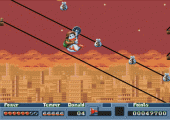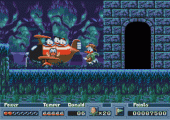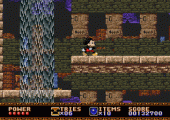Genre: Platform Developer: Sega Ent. Publisher: Sega Ent./ Disney Int. Studios Players: 1 Released: 1998
Castle of Illusion and QuackShot were two of the earliest reviewed games on Sega-16.com, as well as being two of the most beloved platformers on the Mega Drive/Genesis. Despite their legacies, they have not appeared in any of the legion of Mega Drive/Genesis collections released over the last twenty years. Castle of Illusion was most recently given as a pre-order bonus for the digital version of its 2013 remake but only on PlayStation 3. QuackShot was last released with Castle of Illusion in a Sega Ages collection for Saturn in 1998 exclusively in Japan. This release on the Mega Drive a few years before in 1996 and was exclusive to PAL regions, making this collection the last time these games were commercially released outside Japan.
Upon booting up the cart you’re given a simple text-only selection screen and once a game is selected, it runs as if it was the original cartridge. There is no difference to be seen in either title that I could notice. It would have been nice to have seen more effort with the selection screen but this was at a time before you could expect any nice bonuses with game compilations.
The games themselves are a perfect match in many ways but also as full of contrasts as their titular characters. Both titles are built with the same engine and many of the same assets. Yet they are both very distinct, and this is probably the biggest credit to them as they could easily have both been bland platformers that relied on their licenses to attract players. In hindsight we well know that Disney platformers (with very few exceptions), were among the best platformers released on the system and these two games were the pioneers.
Castle of Illusion was the first release, coming out in 1990. Mickey needs to rescue Minnie and this goal is explained in the charming introduction after the Sega logo. Initially, Castle of Illusion looks like a straightforward platformer as Mickey moves through stages jumping on or avoiding enemies, collecting items, and defeating bosses. One immediate difference is that you have to push down while jumping to dispatch enemies or Mickey will be hurt. You can also hit them with apples, marbles, and later with fireballs.
What makes Castle of Illusion special is not so much the gameplay but the varied stages. To this day it is not untypical for games to feature forests, deserts, tundra, and factories. Castle of Illusion begins in a forest is soon followed by Toy Land with marching soldiers and Jack-in-the-Boxes attacking Mickey. The first part of Toy Land is a good example of the game’s variety, as Mickey begins right near the exit but has to climb to the top of the stage to retrieve a key to get there. Once done, rather than a tedious trip back down the stairs collapse into a slope and Mickey takes a quick and exciting trip to the bottom. In the next area the stage is literally flipped upside down at multiple points which mixes up the gameplay even more. The library stage has Mickey getting harassed by giant letter As and bookworms along with detours into dessert-themed areas and even a cup of tea. Or is it coffee? I never have sugar in my tea. Even the areas that are fairly typical of the genre are beautifully designed and the gameplay is rarely as simple as rightward movement from A to B.
The only real criticisms of Castle of Illusion is that it is over too quickly and has a few nasty pitfalls that will surprise new players. Other than that, it holds up well today. The 2013 remake showed a new generation how great it was simply by leaving most of the original design intact.
QuackShot is generally considered to be the lesser title when comparing the two but I’ve always had a soft spot for it. This is mainly because I played this back when it was still new and didn’t come across Castle of Illusion until many years later — though I was always on the lookout for a copy. It was also very much made in the spirit of the DuckTales television series which I also loved as a child. The Disney comic series were also an earlier influence, though I had no knowledge of this at the time.
In another charming little introduction, Donald discovers a treasure map at Uncle Scrooge’s and sets off on an adventure to find it. QuackShot’s gameplay has a number of departures from Castle of Illusion though it is still a platformer at its core. Donald can’t jump on enemies and instead mostly relies on a a plunger gun that temporarily holds enemies in place. He also has a popcorn gun that knocks enemies off screen altogether but ammunition is limited. The bubble gun acquired a bit later does the same, as well as removing block obstacles. Donald will also get two upgrades to the plunger gun during the course of the game to aid traversal. These weapons, along with a number of other items, can be selected from an inventory screen. One underused feature is a very characteristic temper meter for Donald. In a few sections after collecting a number of chili peppers, Donald will fly into a rage that sends him out of control but also confers temporary invincibility from enemies and their attacks. It would have worked better if the developers had found it away to connect it with his power meter but it is a neat addition, nonetheless.
What really differs from Castle of Illusion is the ability to travel back and forth to different locations once new items are acquired. On most stages, Donald will plant a flag at a certain point where he can call on his nephews to pick him up to go to a new location around the world. The choice is something of an… illusion, as there are definite places you need to go and items you specifically need to acquire but it does add to the sense of adventure. The neat jingle whenever Donald takes flight only adds to this.
Also building that sense of adventure are the various locations around the world. Donald will go to Mexico, Egypt, India, and the South Pole, as well as a few trips to Duckburg. These areas are more typical with a platformer with deserts, forests, factories, and three different temples with the same background music. It all fits with the theme though, which makes a number of obvious nods to the Indiana Jones films throughout.
Like Castle of Illusion, Quackshot isn’t a difficult game. It only gets challenging with a few platforming sections and insta-death pitfalls, especially in the later levels. There are no difficulty settings either.
Both have distinct and high quality soundtracks by the same composer, and it is really only the lack of voice samples of the characters that hurts the presentation. These seem like small additions but both would have brought the characters alive as they did in later games. It should be remembered that they were relatively early titles for the console, and both showed what the sound chip could do when used right.
Castle of Illusion and QuackShot have usually been considered welcome additions to any Mega Drive or Genesis library, and that remains true today. Times have certainly changed though, and both titles are now nowhere near as cheap as they were when reviewed here in 2004 and the lack of re-releases further limits their availability. Interestingly, this collection isn’t all that more expensive and, as of this writing, is a cheaper option than buying both separately from my cursory browsing. This is only an option for PAL collectors and probably won’t stay that way long-term. Moreover, the Japanese Saturn release remains rare and very expensive. Whether these games get easier or harder to own physically, they are still two of the best games on the platform. The combined scores for both separately add up to well over ten, so I think giving this collection full marks is fair rounding
SCORE: 10 out of 10










Recent Comments